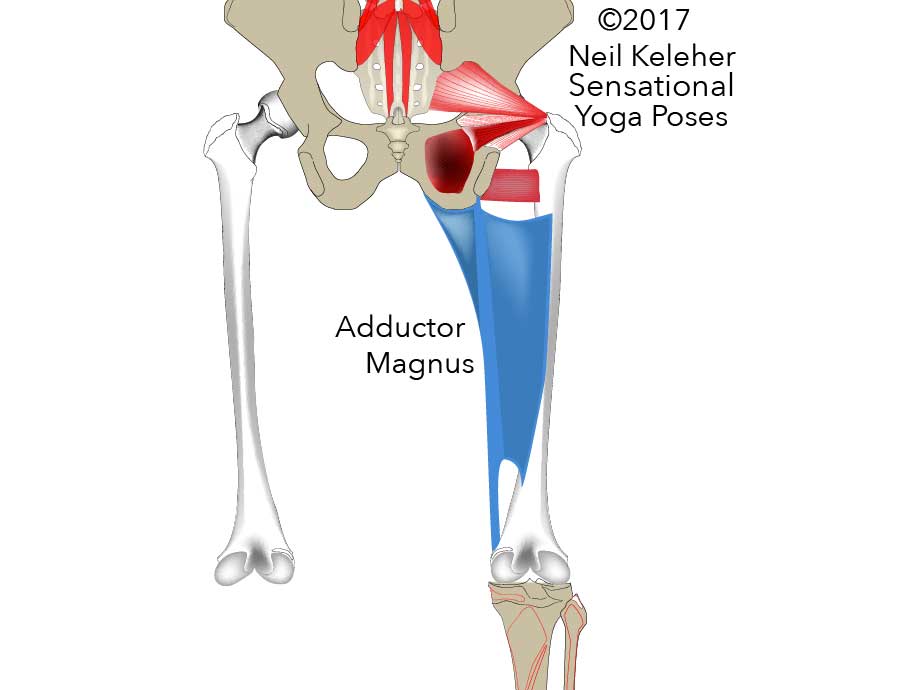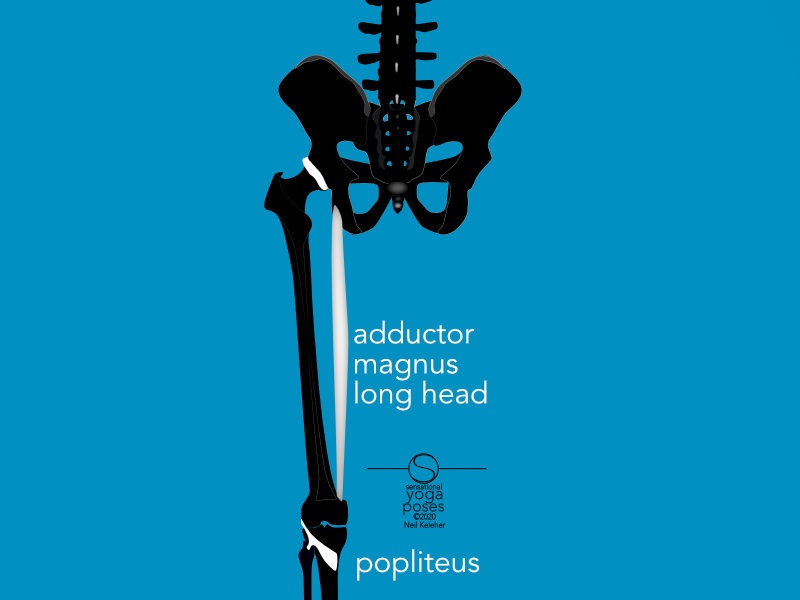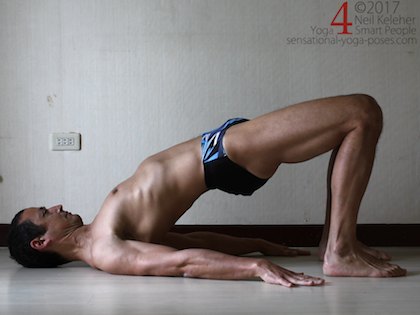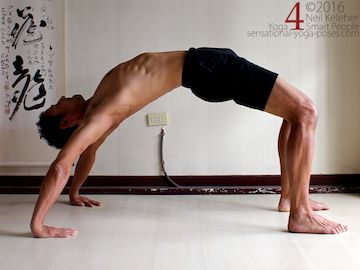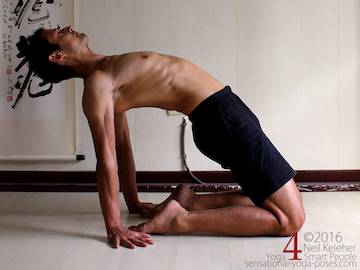An Internal Rotator of the Hip
The adductor magnus long head attaches from the sitting bone to a point on the inside of the thigh bone, just above the knee.
When activated, it creates a rearwards pull on the inside of the thigh helping to rotate it inwards.
It can also help to resist external rotation.
An Extensor of the hip
Like the hamstrings, the adductor magnus long head can also extend the hip. Where the hamstrings may be less effective in hip extension if the knee is bent, the adductor magnus can still function effectively even if the knee is bent.
Another major extensor of the hip is the gluteus maximus. It also acts as an external hip rotator, where the adductor magnus long head is an internal hip rotator.
Controllling Knee Rotation (adductor magnus long head and vastus medialis obliquus)
Something else that should be noted about the hamstrings, particularly the biceps femoris long head and the semitendinosus, is that they help control knee rotation.
Even though it doesn't cross the knee, the adductor magnus long head can also play a role in controlling knee rotation. That's because the lower portion of the vastus medialis muscle (the vastus medialis obliquus) attaches to the tendon at the lower end of the adductor magnus long head.
If the adductor magnus long head is active, the vastus medialis obliquus can activate if required to help control knee rotation.
How to Activate the Adductor Magnus Long Head
While standing with legs straight, one way to deliberately activate the long head of the adductor magnus is to press the inner thighs back without allowing the thigh to rotate.
You should be able to notice a line of tension from the sitting bones to the inside of the thigh just above the knee as you do this.
Using the Adductor Magnus to For Rotationless Extension
When extending the hip, the adductor magnus can work against external rotators like the gluteus maximus to create rotationless leg extension. If the leg is extended horizontally with the knee pointing down, it can also work against the weight of the thigh itself.
An example of this is lifting the leg in extended cat pose.
Adductor magnus long head activation in extended Cat Pose
Starting on all fours, in cat pose (what some call table top pose), reach one leg straight back with the knee pointing down.
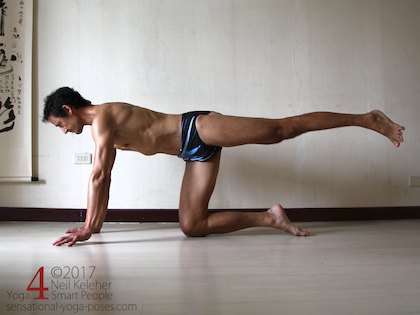
Extended Cat Pose
Pull upwards on the inside of the knee and allow the weight of the leg to hang down so that the knee naturally points down.
It can feel like the leg is hanging from the inner knee.
Try using your adductor magnus long head to lift the leg higher without using your gluteus maximus.
To make this action easier, try tilting the pelvis forwards first so that you increase the lumbar lordosis as you lift your leg higher.
You could tilt your pelvis forwards first and then lift the leg higher or lift the leg higher as you tilt your pelvis forwards, as if moving your leg and pelvis as one unit.
In this case, to lift the leg higher you aren't so much increasing hip extension as you are tilting the pelvis forwards and extending the lumbar spine.
Anchoring the adductor magnus long head for effective muscle function
Whether your aim is to keep the leg horizontal in extended cat pose or to lift it higher into extension, one idea that is important in any deliberate muscle activation is giving the muscle you are activating an anchored end point from which to act.
If tilting the pelvis forwards, you anchor the upper end of the adductor magnus since the sitting bones are moving upwards (or in the case of extended cat pose, forwards).
If you wanted to anchor the adductor magnus long head where it attaches to the thigh then you would do so by creating an external rotation force for the adductor magnus long head to work against.
In extended cat pose this can come from the weight of the leg itself.
When not working against the weight of the leg, this force can be provided by the gluteus maximus and other external hip rotators.
Using Adductor Magnus in Bridge Pose and Wheel Pose
Adductor magnus could be used in back bending yoga poses like Bridge Pose and Wheel Pose to help lift the pelvis.
In either of these two poses, with your hips lifted, focus on pressing the inner thighs down (toward the floor) to activate your adductor magnus. Keep your pelvis lifted as you press your inner thighs down. And as suggested before, prevent your knees from moving inwards when pressing your inner thighs down.
Keeping your Knees Pointing Forwards
Because the long head of the adductor magnus is an internal rotator, activating it in bridge and wheel pose may help you to keep your knees pointing in the same direction as you toes. But prior to lifting up, I'd suggest that you set your feet up so that they are parallel.
Camel Pose
Another backbending posture where the Adductor Magnus may be useful is in Camel Pose.
In extended cat pose you lift one leg and move the leg backwards with respect to the pelvis (or actually, upwards.)
In wheel and bridge you use the legs to push the pelvis upwards. Because the feet are in the floor in both of these poses, the result is that the pelvis moves up relative to the legs.
For camel pose you can start from a kneeling position. You may find it comfortable to have your shins about hip width (or maybe even shoulder width) apart. You could work at keeping your shins parallel or allow your feet to move towards each other a comfortable amount
Use a position that is comfortable given what you are trying to do.
With your hands on the floor, push your hips forwards and up. Once your hips are lifted, you can recruit adductor magnus by pushing rearwards on your inner thighs while continuing to push forwards through your pelvis.
Adductor Magnus and Dropping Back
Although I am not expert at dropping back (it's one of those actions that I had for a while and then didn't do for awhile and then got too scared to actually do the drop back) when I was doing drop backs I did them with my feet turned out alot. I'd collapse into my arches which made it easier to push my knees forwards so that then I could get my center over my feet. This made it easier to drop back and land on my hands and also to pull back up to standing.
I recently tried to do a standing back bend (without actually dropping back) and found that pushing the inner thighs back while pushing my pelvis forwards allowed me to bend back fairly deeply. However another component of this was pulling the sitting bones inwards and the tailbone forwards, towards the pubic bone.
In view of what I recently wrote about the SI Joint and stabilizing it the opposite action, moving the tailbone rearwards and sitting bones outwards, might actually be more appropriate.
To make this more achievable you could start by bending your spine backwards first. As you do this, spread your sitting bones and move the tip of the tailbone way from yoru pubic bone.
Keep the spinal back bend and the aforementioned positioning of the sitting bones and tailbone, then tilt your pelvis and spine backwards as one unit. So, bend the spine backwards first, then keeping the spinal back bend, bend backwards at the hips. As you bend back at the hip try pressing the inner thighs rearwards to activate your adductor magnus long head.
If you find any of this uncomfortable, either on your low back, hips or knees, then leave it out. There are other methods for approaching a standing back bend.
And that is actually the bigger point of all articles that I write. Experiment, and while experimenting see for yourself what works and doesn't work. And continue to experiment because what doesn't work one day may actually work very well on another day.
Pushing the Inner Thighs Forwards
Although I've talked mainly about activating the adductor magnus by pushing the inner thigh back (and it's my assumption that it's the adductor magnus that is activated by doing this "action") There are also times where I've experimented with pushing the inner thighs forwards.
While this may not be the adductor magnus that is activating, it's good to be aware of this potential action. I've found that if I'm not sure what to do, I try both and see which works best.
In this case, it may be the sartorius that is activating or the gracilis or both.
One other area where pressing the inner thigh back or forwards may be helpful is when doing one legged balancing poses. I've found that when standing on one leg pressing the inner thigh forwards (half moon pose) or backwards (warrior 3, tree pose, eagle?) helps to make the standing leg more stable. And it also helps when standing up from triangle pose (press the inner thigh of the front leg "forwards.")
Creating Space in the Hip Joint
In the hip joint article I talked about creating space in the hip joint using the obturators and the gemellus, all of which are external rotators.
I also suggested that this external rotation is probably counted by the Adductor Magnus to keep the thigh from rotating. (possible the TFL and gluteus minimus as well.)
It may be that if you press your inner thigh back a natural response is for the obturators and gemellii to activate and so activating the adductor magnus may automatically help to create space in the hip.
But if it doesn't, you could experiment with activating adductor magnus (by pressing down with the inner thigh, or back if you are standing) while at the same time making your thigh feel long.
Sitting upright with legs straight ahead you could focus on pushing the inner thighs forwards and down to activate both sets of muscles. You can try using this action in any forward bending hamstring stretch.
So that you can lengthen your hamstrings with greater ease you can also experiment with engaging your buttocks at the same time so that they take the strain of supporting your upper body. You can then gradually tilt the pelvis forwards using the gluteus maximus as the controlling muscle.
Note that this can feel like a "spreading" or in Richard Freemans' words a "flowering or blossoming" of the buttocks. (actually those aren't his words, but I'm sure he said something like that, while at the same time reminding me of a bushy eyebrowed agent smith from the matrix.)
Published: 2020 08 04
Updated: 2023 03 23
